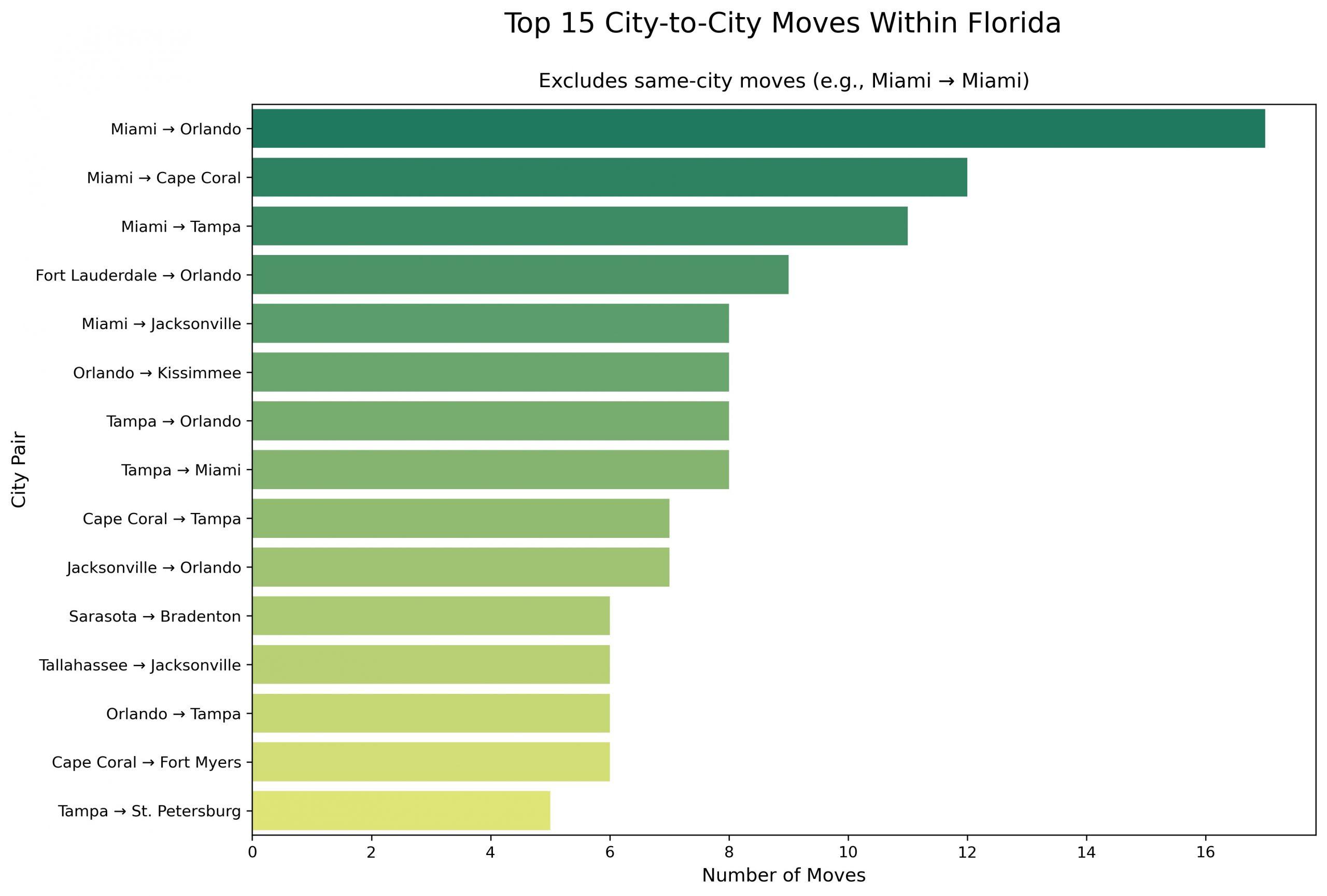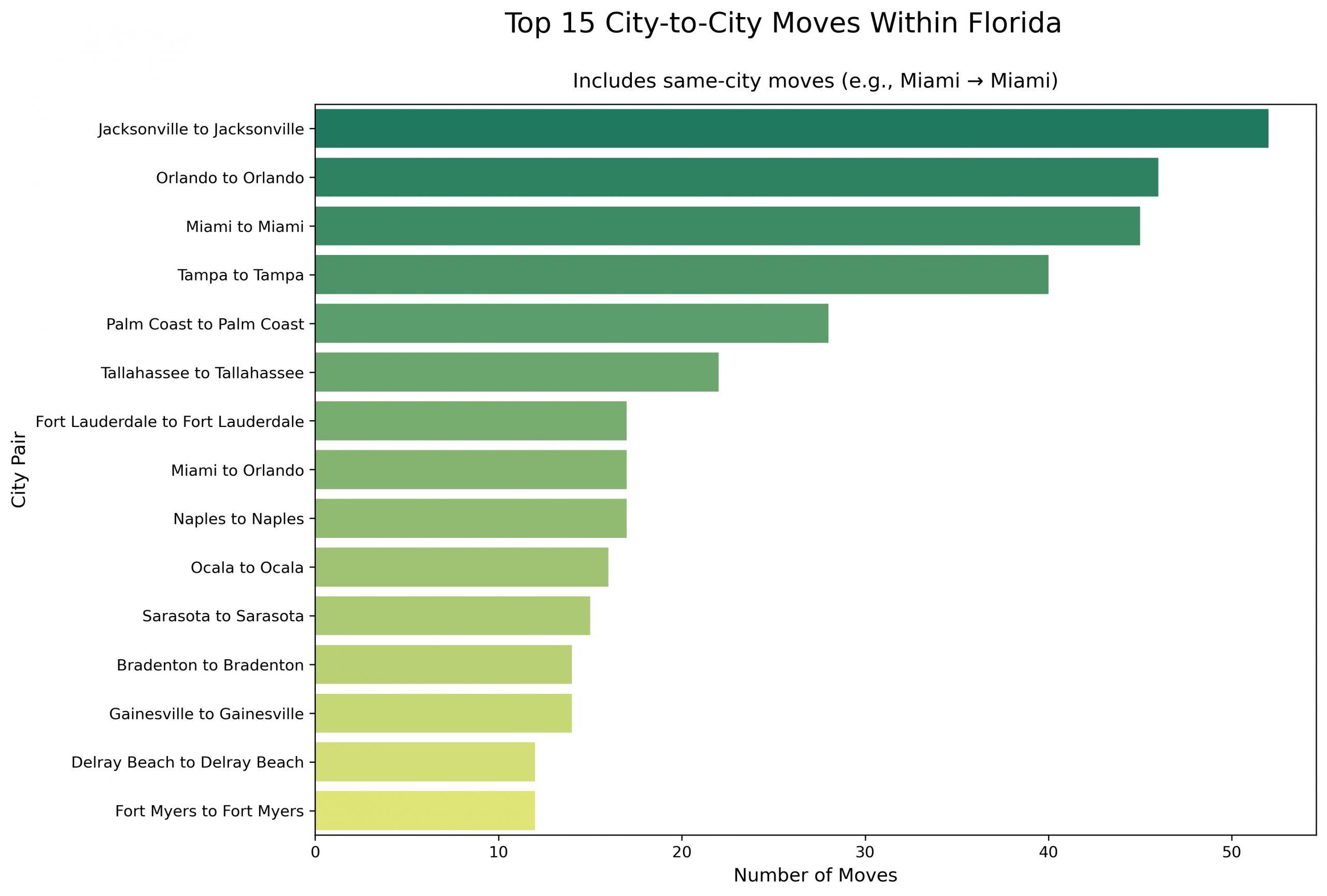Where is Florida Moving?: The Biggest Trends in 2025

In 2022, Florida was the fastest-growing state in the country. But today? The state is suffering a popularity crisis. Though 1.1 people still move into Florida for every move outbound, flat growth and transplants rethinking their choice have made for a post-pandemic hangover.
Mortgage applications are down, while those in neighboring states are rising. Young people are leading an outflow that’s second only to California’s. High demand has fueled rising real estate prices. Throw in worsening storms that are, in some cases, doubling insurance rates, and many are throwing in their flip flops and calling it quits.
Some Floridians are heading to other states, but which ones? Where are people are moving within Florida? Which less-popular cities are emerging as up-and-coming destinations? Who is still moving to Florida in 2025?
We analyzed moveBuddha’s moving calculator visits to see where Floridians are moving and who is moving to Florida.
What did we find?
In 2025, north and central Florida cities are quietly crushing it, New England states like New Hampshire are still shipping snowbirds south by the SUV-load, and those who leave are most likely to head to North Carolina.
Key Takeaways
- When Floridians relocate in-state in 2025, they’re most likely to be heading to Orlando, with 60% more moves to the central Florida oasis compared to the #2 destination, Jacksonville.
- Kissimmee, Ocala, and The Villages attract the most new moves compared to those exiting. While they can’t attract the raw numbers that big cities can, they’re more likely to see the impacts of their high popularity.
- While Jacksonville gets more searches for moves within the city (13% more likely than Orlando), on a per capita basis, Orlando’s enticing more residents to stay put. Its residents are more than 2X as likely to move within their own city compared to residents of Jacksonville.
- Roll out the welcome wagon to New Hampshirites. With 7.7 moves to Florida per 100K residents, they’re sending more of their population to Florida than any other state.
- Saying Sayonara to the Sunshine State? Join more of your former neighbors in North Carolina, which sees the most outbound move interest from Floridians today.
For Floridians, Orlando is a Magnet

Orlando is the Florida city that benefits the most from relocations from other parts of the state.
Central Florida’s major tech and entertainment hub attracts ~60% more in-moves from elsewhere in the state compared to #2 Jacksonville and ~87% more moves than #3 Tampa. Further, the most popular move route within Florida in 2025 so far is Miami to Orlando, in which .85% of the state’s overall move traffic consists of southern Floridians making the trek north.
Orlando boasts a lower cost of living (home costs are a whopping 42% less than in Miami) and a new high-speed rail connection between the 2 cities. That means that everyone from remote workers seeking to save to families looking to upsize their living spaces (not to mention new employees of Lockheed Martin, Siemens, or EA Sports, all with significant operations in town) can find Orlando a compelling alternative to South Florida’s density and price tag.
Hialeah is the least likely destination for inter-Floridian moves. With the fewest inbound move requests among Florida’s 20 largest cities, it’s a city people stay in, but few move to, with just 1.36 moves per 100K residents.
Kissimmee Attracts More Move-Ins Compared to Move-Outs of Any Florida City
Orlando comes in #5 among Floridians’ favorite move destinations on a per capita basis, so while it’s attracting and keeping more residents than other cities, some smaller cities are seeing even higher in-migration interest, which could lead to greater impacts on their local economies.
Kissimmee, Ocala, The Villages, and Wesley Chapel all receive more than double the inbound move interest than move-outs, making them the most in-demand destinations for in-state moves relative to their size. While only Kissimmee falls squarely within the Orlando metro, all sit within a 90-minute drive from downtown Orlando and are part of a greater central Florida exurban growth belt.
With an in-move ratio of 3.15 to 1, Kissimmee is the most popular. Its home prices are under the Orlando average, and with easy access to the city, Lake Tohopekaliga, and theme parks, it’s no surprise that Kissimmee appeals to movers.
To put this stratospheric popularity in perspective, Kissimmee attracts 9.84 new moves per 100K residents, while last-place Miami Gardens sees fewer than one single new move inbound for every 100K residents.
Jacksonville Keeps More Residents, But Orlando is Stickiest Per Capita

When planning a move in-state, Jacksonville residents are more likely than any other city to say they’re staying in-town, relocating to a larger home or a nearby suburb, rather than seeking out a new city.
Jacksonville residents are 13% more likely to plan a move in town compared to Orlandoans.
But that’s not the whole story. Jacksonville’s 1 million+ population dwarfs that of its southern neighbor, so, on a per capita basis, Orlando sees 14.38 per 100K residents moving intra-city, while Jacksonville sees just 5.89 per 100K of its residents doing the same.
Overall, Orlando residents are 50% more likely to relocate within their own city than to move to another part of Florida. The bottom line: Orlando is attracting outsiders. It’s also keeping its own.
When it comes to the cities left behind, Tallahassee residents are the most likely to leave their city for other Florida locations. The capital is losing 10 residents per 100K to other Florida cities this year.
Granite Staters are Moving to Florida in 2025
- New Hampshire
- New Jersey
- Connecticut
- Vermont
- Massachusetts
- Maine
- Rhode Island
- Colorado
- New York
- Delaware
Among all states, Florida ranks 18th for its in-to-out move ratio and 16th in net in-moves overall.
What does that mean?
First, Florida actually fares better than average in both ratio and net inward migration, and second, reports of its demise have been greatly exaggerated, though the curve is somewhat flat, with just 1.1 person moving into Florida for every leaver.
New England is responsible for many of those newcomers, sending more of its residents to Florida in 2025 than any other region.
On a per capita basis, New Hampshire packs the biggest punch, creating 7.7 new Floridians southbound per 100K people. That’s 45% higher than New Jersey, which sends 5.3 people per 100K to the Sunshine State. However, neither can match the raw numbers of residents that New York loses to Florida.
While Northeasterners and New Englanders often set their sights on Florida, the same can’t be said for the other side of the map: Alaska sends the fewest new residents, with just .9 Florida moves per 100K people.
Floridians Who Leave are Heading to North Carolina
- North Carolina
- Texas
- New York
- Georgia
- California
- Tennessee
- Pennsylvania
- Virginia
- Illinois
- South Carolina
When Floridians decide to move out of state, their #1 destination is North Carolina, with the largest raw number of outbound searches compared to other states, but also the highest outbound ratio per capita. North Carolina, Texas, and New York all contribute more than 2 new residents to Florida’s melting pot per 100K people.
North Carolina’s appeal among Floridians, especially retirees, is so notorious that it has a name: half-backs are retirees who tried Florida, then decided to relocate part of the way home, making a trade-off in both humidity and senior services.
It’s rarer than we thought to make the Boomerang trip: only 17.6% of Floridians searching for a move say they’re headed out-of-state (the 3rd-lowest ratio of all states).
Less Flip or Flop: More Shuffle and Stay
Florida is no longer the unchallenged darling of domestic migration. While the pandemic’s frenzy is over, it left behind a changed Florida landscape that’s given rise to more nuanced internal trends: while South and coastal areas cool, inland cities like Orlando and surrounding cities, like Kissimmee and Ocala, are taking off.
And while some Floridians are heading for the hills (hi, North Carolina), many others are staying home, just swapping Miami’s high rises and traffic jams for Orlando’s comfortable ‘burbs. Further, those cities of tomorrow aren’t just attracting out-of-towners: they’re keeping their own for the long-term.
Instead off massive migration, the Florida of 2025 is seeing local surges and state-wide trade-offs. The people who are leaving? They’re a little more selective. Those who are coming? They’re more intentional. Overall, the state isn’t emptying, but it is shifting and evening out.
It turns out that Florida’s future won’t be defined by who is coming or going, but by where they land when they do.
Methodology
We analyzed data from the moveBuddha Moving Calculator from January 1, 2025 to June 1, 2025, comparing move origins and destinations for moves planned this year.
Not all these inquiries will result in a completed move, but they’re likely to be proportional to those that take the leap, and they provide up-to-the-minute insight about what Americans are planning to do in 2025, versus year-old census data about what they actually did.
What did we find? Comparison data on moves to or from Florida involving 323 U.S. cities and 58 cities representing routes within Florida.
Not what you were looking for?
Check out other categories that can help you find the information you need!

